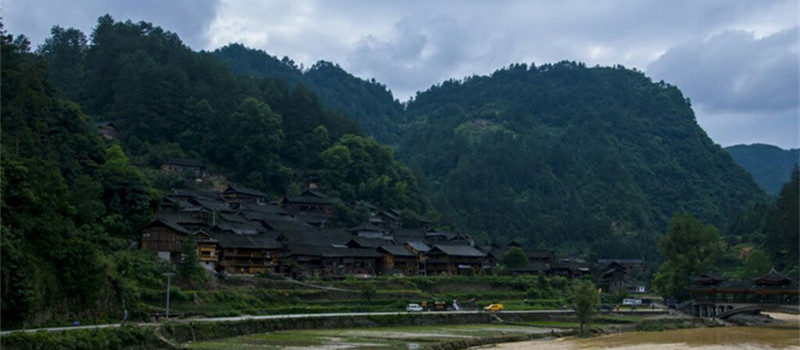- Home
- Travel In China > China Attractions > Guizhou Attractions >
Zhouxi Miao Village
Zhouxi Miao Village, located about 20 kilometers south of
Kaili City. What makes Zhouxi so special is its lively Lusheng Festival, where each village contributes with a Lusheng band (a lusheng is a special reed instrument – more on this below), and where the bands take turns at performing during the three days that the Lusheng Festival takes place (it begins on the twentieth day of the first lunar month, which corresponds to roughly the end of January/ the beginning of February in the Western calendar).
The original purpose of the Lusheng Festival was to provide an opportunity for courtship among young people, but today the Lusheng Festival has become a much more general annual celebration, though the courtship ritual is still at the heart of the Lusheng Festival.

Mothers accompany their daughters to the festival, the daughters done up in their very best Lusheng costumes, which is a festival costume ornately embroidered and adorned with much silver jewelry (a hip-hopper would be envious of this much bling-bling!). Boys, in contrast, no longer wear a special Lusheng costume. A host of courtship rituals are played out at the Lusheng Festival, among them one where the young males of the villages play Lusheng pipes while forming a circle, and the girls respond with a sequence of dance steps designed to show off their costumes to the best advantage. The two most distinguishing features of a Miao girl's Lusheng costume are: the silk brocade that appears mainly on collars, sleeves, and the breast of the blouse as well as on the front of the skirt; and the silver coat and headdress, the costume's main source of bling-bling, or silver-jewelry ornamentation. The silver headdress is topped with a pair of sacred buffalo (oxen) horns that are intended for religious purposes, not for display (they are not generally visible, being located in the top of the headdress).
A lusheng, as indicted, is a reed instrument. It is made of bamboo and can measure up to 3 meters or as little as 1/3 meter. Most lusheng consist of multiple reeds, but some have only 1 or 2 reeds. The most popular number of reeds for a lusheng among experienced lusheng musicians is 6, which provides an adequate range of tones, from a deep bass to a clear and melodious treble, while maintaining forcefulness. The music of the lusheng has over time been played for more than just the traditional courtship ceremony – the lusheng has developed into an all-purpose musical instrument in its own right, an instrument used to accompany all manner of dance, acrobatics, and even Wushu, a special aerobics-like Chinese form of physical workout. Because of its versatility, the lusheng is gradually being adopted by other Chinese minority cultures than the Miao, such as those of the Buyi, the Dong, the Shui, the Yao and the Yi, and it is perhaps only a matter of time before it makes its way into Western culture.
The Lusheng Festival not only defines Zhouxi's Miao villages, it is intimately related to the livelihood of these villages, since silk brocade and the lusheng itself are considered the "two treasures of Zhouxi" – they are both produced here. Ganangxiang Lusheng Hall in Zhouxi, built during the Ming (CE 1368-1644) Dynasty, has several hundred years' history behind it; Ganangxiang Lusheng Hall is not only the largest such hall in Guizhou Province, it is also the most popular venue for the Lusheng Festival in the entire region.
Travel Tips
Add: Zhouxin Town,Kaili City,Guizhou Province
Opening Hours: 08:00-18:00
Entrance Fee: CNY 50


 Ask Questions ?
Ask Questions ?